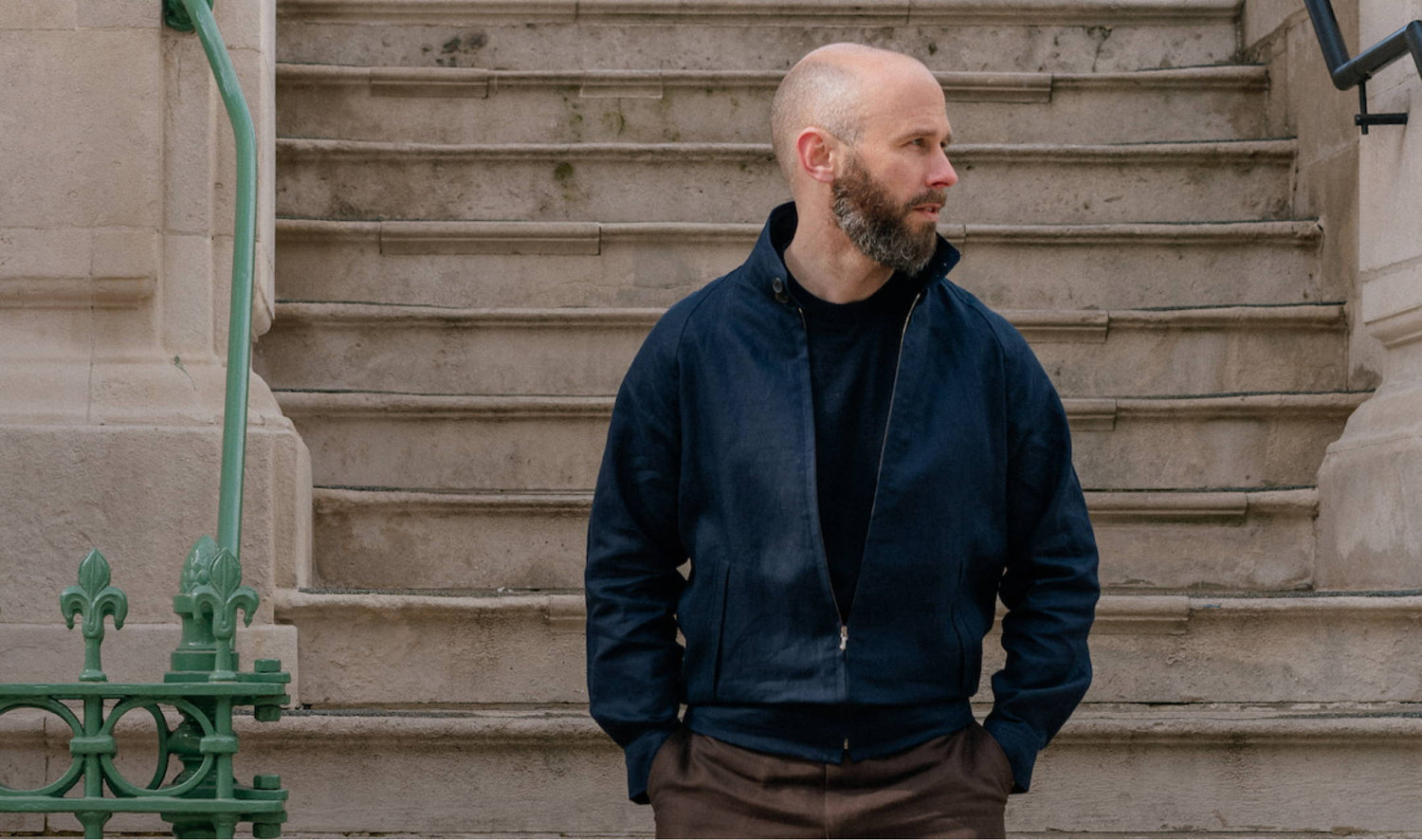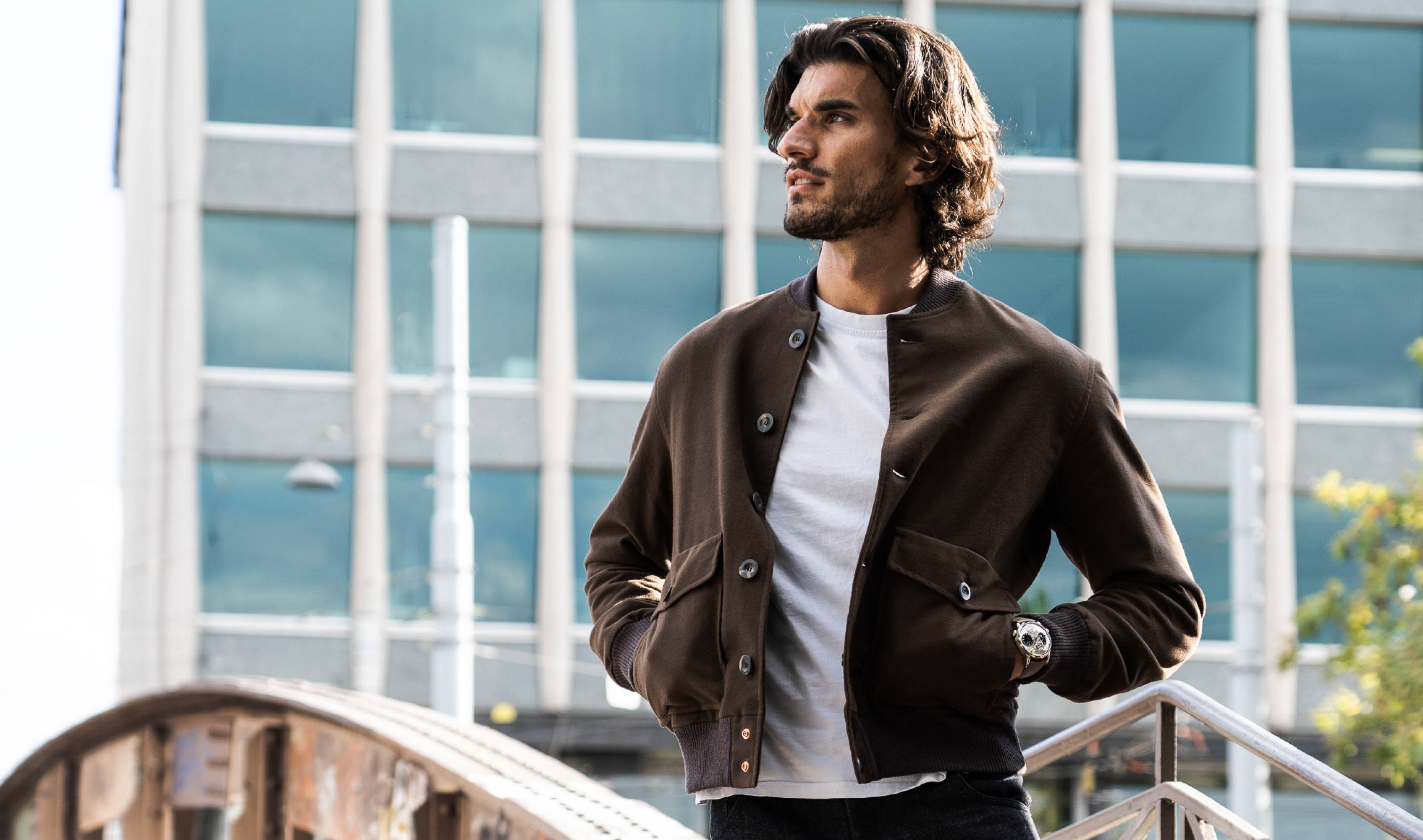The Permanent Style Linen Harrington
I used to have a linen bomber jacket from Hermes. It was a beautiful piece of clothing, lightweight and cool, and I loved wearing it with both shorts and tailoring in the summer.
Unfortunately the design had some flaws (in my view); it had a tiny collar, no pockets, and a slightly A-line body shape.
Then, last year, I picked up a vintage Harrington-style jacket from Levison’s. From what I can tell, this was made in the 1940s or 50s - not a G9, but English and with a wonderful roomy cut.
I wore it quite a bit last summer, but the cotton made it much more of a casual piece. So the thought occurred: what would a version be like in linen, like that old Hermes bomber? Would it be just as versatile, and pleasing if it had that classic blouson shape?
This led the team at Private White V.C. and myself down a rabbit hole of linens, zippers and back yokes, and eventually to the piece we’re launching today: The PS Linen Harrington. I have to say I’m very happy with it. I prefer it to both the vintage Harrington and the Hermes, and I think it’s more useful than both.
The linen is light - 270g - and so air passes through easily. On the couple of recent days when the temperature touched 20 degrees in London, I tried it and hardly felt like I was wearing an outer layer at all. I’m looking forward to wearing it when the heat is closer to 30.
On the back of the jacket, I was keen to keep the large, shaped back yoke of a traditional Harrington. It’s a nice detail, and rather flattering too - emphasising the width across the shoulders.
Of course, on those originals, the point of the yoke was the provide a double layer against the rain, when you were out on the fairway and caught in a downpour.
As this jacket was meant to be cool, we didn’t want two layers of linen there. So instead, we decided to leave a gap between the two parts of the back, held together at the points of the yoke.
This means not only that there is just a single layer of linen on the back, but that there are three small vents that can let a little air through, cooling the back even further.
This practicality had to be the most important thing of the design: it is made for the heat, and had to be effective.
But the aspect of the jacket I love most is the silhouette.
It is deliberately cut close at the waist. So when you try it on for the first time you may have to pull the two sides together slightly, to zip it up.
This is easy to do, because there are two panels of elastic at the back of the jacket (not all the way round - rather more elegant); and when it’s fastened, the tightness means that the waistband stays fixed on the hips, allowing the blouson-shape of the body to bloom above.
This is looks good to my eye, creating a larger upper body, and I love particularly how that looks with a pair of sharp trousers running straight down below.
But it’s also surprisingly cool. The closed waistband means you’re getting less airflow, but the blousy body moves and billows, pushing air around and through the linen.
That was one of the things that surprised me about that Hermes jacket, the first time I wore it.
This body shape is complimented, I think, by the zip and collar.
These were made deliberately so that front edge doesn’t collapse, but runs in a nice bow up the chest, and is held at the top by the double-layered collar.
This shape is what I always loved about a Harrington-style jacket, zipped perhaps a third of the way up. You can see how nice that is in suede too with the Purple Label jacket shown in the recent T-shirt shoot.
Of course, if it is too hot to keep the jacket closed, then you can leave it open, and even here I find the firm zip line helps the front look good.
The sleeves are also easy to fold back, so if you want to be even cooler and don’t mind that more casual look, you can wear it as I am below, with them rolled.
In summer, at least half the point of wearing a jacket like this is to have pockets, so we put two simple patches on either side of the chest.
They’re 11cm by 13cm, so will fit quite a lot of mobile phones and certainly a card wallet or similar. Anything bigger would have required not just the more material for the pocket, but also the facing, sacrificing the coolness a little too much. The contents also become disproportionately heavy.
The jacket has two hip pockets, but they’re made with the welt facing downwards, so they stay sharp and closed if not in use. This was originally done on golf jackets against the rain too, but I like the fact that the front looks that much cleaner - particularly on a jacket as dark and simple as this one.
Elsewhere there are details you’d expect on a PS piece, such as the two-hole, unpolished horn buttons used on the other PWVC collab coats. The RiRi zip is also deliberately small and elegant.
In order to demonstrate the versatility I mentioned earlier, I’ve shown the jacket with three different outfits, and different levels of smartness.
First with jeans, simple and casual. A white T-shirt, vintage seventies light-wash jeans, and black espadrilles.
The second still has a T-shirt, but it’s a knit from The Anthology, and the trousers are tailored brown linen, from Edward Sexton. The shoes are Sagans from Baudoin & Lange.
That second outfit is smarter but the colour palette, tonal and dark, is also perhaps more modern.
The last outfit is more tailored: a blue linen shirt, high-twist trousers and still black shoes but with a welt to them. Here the Harrington is more a substitute for a navy blazer - and indeed would be a good travelling companion alongside a hopsack jacket.
I know some readers will ask how this jacket compares to the Linen Overshirt. I think, actually, they have pretty similar uses but just different styles.
The Harrington is arguably a touch more casual, because of its shape, and a better fit for jeans. But I think the overshirt is nice with jeans too. The overshirt is perhaps cooler because you’ll more likely wear it open; but actually its made with slightly heavier linen than the bomber, beause it needs it to retain shape.
The difference is more one of style. And just like you might have both a field jacket and a suede blouson for autumn, so both of these can work in the summer.
The PS Linen Harrington costs £595 and is available now while stocks last.
Words by Simon Crompton
The Permanent Style Linen Harrington
I used to have a linen bomber jacket from Hermes. It was a beautiful piece of clothing, lightweight and cool, and I loved wearing it with both shorts and tailoring in the summer.
Unfortunately the design had some flaws (in my view); it had a tiny collar, no pockets, and a slightly A-line body shape.
Then, last year, I picked up a vintage Harrington-style jacket from Levison’s. From what I can tell, this was made in the 1940s or 50s - not a G9, but English and with a wonderful roomy cut.
I wore it quite a bit last summer, but the cotton made it much more of a casual piece. So the thought occurred: what would a version be like in linen, like that old Hermes bomber? Would it be just as versatile, and pleasing if it had that classic blouson shape?
This led the team at Private White V.C. and myself down a rabbit hole of linens, zippers and back yokes, and eventually to the piece we’re launching today: The PS Linen Harrington. I have to say I’m very happy with it. I prefer it to both the vintage Harrington and the Hermes, and I think it’s more useful than both.
The linen is light - 270g - and so air passes through easily. On the couple of recent days when the temperature touched 20 degrees in London, I tried it and hardly felt like I was wearing an outer layer at all. I’m looking forward to wearing it when the heat is closer to 30.
On the back of the jacket, I was keen to keep the large, shaped back yoke of a traditional Harrington. It’s a nice detail, and rather flattering too - emphasising the width across the shoulders.
Of course, on those originals, the point of the yoke was the provide a double layer against the rain, when you were out on the fairway and caught in a downpour.
As this jacket was meant to be cool, we didn’t want two layers of linen there. So instead, we decided to leave a gap between the two parts of the back, held together at the points of the yoke.
This means not only that there is just a single layer of linen on the back, but that there are three small vents that can let a little air through, cooling the back even further.
This practicality had to be the most important thing of the design: it is made for the heat, and had to be effective.
But the aspect of the jacket I love most is the silhouette.
It is deliberately cut close at the waist. So when you try it on for the first time you may have to pull the two sides together slightly, to zip it up.
This is easy to do, because there are two panels of elastic at the back of the jacket (not all the way round - rather more elegant); and when it’s fastened, the tightness means that the waistband stays fixed on the hips, allowing the blouson-shape of the body to bloom above.
This is looks good to my eye, creating a larger upper body, and I love particularly how that looks with a pair of sharp trousers running straight down below.
But it’s also surprisingly cool. The closed waistband means you’re getting less airflow, but the blousy body moves and billows, pushing air around and through the linen.
That was one of the things that surprised me about that Hermes jacket, the first time I wore it.
This body shape is complimented, I think, by the zip and collar.
These were made deliberately so that front edge doesn’t collapse, but runs in a nice bow up the chest, and is held at the top by the double-layered collar.
This shape is what I always loved about a Harrington-style jacket, zipped perhaps a third of the way up. You can see how nice that is in suede too with the Purple Label jacket shown in the recent T-shirt shoot.
Of course, if it is too hot to keep the jacket closed, then you can leave it open, and even here I find the firm zip line helps the front look good.
The sleeves are also easy to fold back, so if you want to be even cooler and don’t mind that more casual look, you can wear it as I am below, with them rolled.
In summer, at least half the point of wearing a jacket like this is to have pockets, so we put two simple patches on either side of the chest.
They’re 11cm by 13cm, so will fit quite a lot of mobile phones and certainly a card wallet or similar. Anything bigger would have required not just the more material for the pocket, but also the facing, sacrificing the coolness a little too much. The contents also become disproportionately heavy.
The jacket has two hip pockets, but they’re made with the welt facing downwards, so they stay sharp and closed if not in use. This was originally done on golf jackets against the rain too, but I like the fact that the front looks that much cleaner - particularly on a jacket as dark and simple as this one.
Elsewhere there are details you’d expect on a PS piece, such as the two-hole, unpolished horn buttons used on the other PWVC collab coats. The RiRi zip is also deliberately small and elegant.
In order to demonstrate the versatility I mentioned earlier, I’ve shown the jacket with three different outfits, and different levels of smartness.
First with jeans, simple and casual. A white T-shirt, vintage seventies light-wash jeans, and black espadrilles.
The second still has a T-shirt, but it’s a knit from The Anthology, and the trousers are tailored brown linen, from Edward Sexton. The shoes are Sagans from Baudoin & Lange.
That second outfit is smarter but the colour palette, tonal and dark, is also perhaps more modern.
The last outfit is more tailored: a blue linen shirt, high-twist trousers and still black shoes but with a welt to them. Here the Harrington is more a substitute for a navy blazer - and indeed would be a good travelling companion alongside a hopsack jacket.
I know some readers will ask how this jacket compares to the Linen Overshirt. I think, actually, they have pretty similar uses but just different styles.
The Harrington is arguably a touch more casual, because of its shape, and a better fit for jeans. But I think the overshirt is nice with jeans too. The overshirt is perhaps cooler because you’ll more likely wear it open; but actually its made with slightly heavier linen than the bomber, beause it needs it to retain shape.
The difference is more one of style. And just like you might have both a field jacket and a suede blouson for autumn, so both of these can work in the summer.
The PS Linen Harrington costs £595 and is available now while stocks last.
Words by Simon Crompton















Leave a comment
This site is protected by hCaptcha and the hCaptcha Privacy Policy and Terms of Service apply.